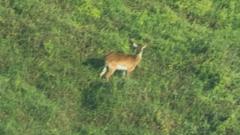In a groundbreaking achievement, wildlife researchers have successfully captured the first-ever photograph of the critically endangered Upemba Lechwe antelope, a species teetering on the brink of extinction. The unveiling took place in the Kamalondo Depression, located in southern Democratic Republic of Congo, where wildlife experts conducted an aerial survey and found just 10 individuals of this elusive antelope, underscoring a population estimate that has dwindled to fewer than 100.
Manuel Weber, who led the survey and subsequent research, conveyed the precarious status of the Upemba Lechwe, stating, "We are truly on the very brink with this species." The Upemba Lechwe stands out from other antelopes due to its unique features, including the absence of dark stripes on their legs and shoulders. In an official statement from Upemba National Park, Weber described the location where the Upemba Lechwe were seen as "a magical place in terms of biodiversity," but noted the extreme challenges that face conservation efforts in the region.
Human activity is rapidly encroaching on the antelope's habitat, with rising populations, fishing, and hunting posing significant threats to the local ecology. Weber cautioned that while it was "extraordinary" that the Upemba Lechwe has managed to survive until now, they risk complete disappearance without immediate and concerted protective measures. "This may be our only chance to save this species," he stated.
The study, published in the African Journal of Ecology, marks the first concerted attempt to survey the Upemba Lechwe in more than half a century. As wildlife conservation increasingly grapples with the dual challenges of human intervention and climate change, this discovery shines a light on what's at stake and the urgent action required to safeguard one of Africa's rarest antelopes.




















